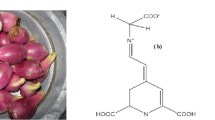Abstract
Environmental pollution is one of the major issues facing all countries throughout the world. Environmental degradation is occurring and creating crises in day-to-day life due to the increasing amount of chemicals used in industries, where even the effluents processed out after treatment also contain some trace elements. Hence the extraction of enzymes using natural methods is an alternative for the production of dye in order to reduce pollution, which in turn helps to nourish and protect the environment for future generations. Hibiscus sabdariffa (L.) is a rich source of anthocyanins that is further enhanced by callus formation and accumulated by increasing the sucrose concentration. Anthocyanin pigments were extracted using acidified ethanol. The dye obtained was screened by GC–MS analysis and its dyeing process used in the textile industry. The study showed certain properties affected the coloring nature depending on the cloth used. The color of anthocyanin pigment depends on the pH maintained and also shows adaptability to varied environmental conditions.







Similar content being viewed by others
Data Availability
Not Applicable.
References
Gheller, A. C. G. V., Kerkhoff, J., Vieira Júnior, G. M., de Campos, K. E., & Sugui, M. M. (2017). Antimutagenic effect of Hibiscus sabdariffa L. aqueous extract on rats treated with monosodium glutamate. The Scientific World Journal, 2017, 1–9.
Tributsch, H. (2004). Dye sensitization solar cells: A critical assessment of the learning curve. Coordination Chemistry Reviews, 248(13–14), 1511–1530.
Makkar, H., Bluemmel, M., Borowy, N., & Becker, K. (1993). Gravimetric determination of tannins and their correlations with chemical and protein precipitation methods. Journal of the Science of Food and Agriculture, 61, 161–165.
Kumar, S. S., Manoj, P., & Giridhar, P. (2016). Micropropagation for mass multiplication and enriched production of ascorbic acid in tissue culture foliage of roselle (Hibiscus sabdariffa L.). In Vitro Cellular & Developmental Biology - Plant, 52, 427–436.
Rosli, N. N., Sabani, M. M., Shahimin, N., Juhari, S., Shaari, M. F., Ahmad, & Zakaria, N. (2021). Dyes extracted from Hibiscus sabdariffa flower and Pandannusamaryllifolius leaf as natural dye sensitizer by using an alcohol-based solvent. Journal of Physics: Conference Series, 1755(1), 1–9.
Majiya, H., & Galstyan, A. (2020). Dye extract of calyces of Hibiscus sabdariffa has photodynamic antibacterial activity. A prospect for sunlight-driven fresh produce sanitation, 8(7), 3200–3211.
Abeda, H. Z., Kouassi, M. K., Yapo, K. D., & Kouakou, H. T. (2014). Production and enhancement of anthocyanin in callus line of Roselle (Hibiscus sabdariffa L.). International Journal of Recent Biotechnology, 2(1), 45–56.
Konappa, N., Udayashankar, A. C., Krishnamurthy, S., Pradeep, C. K., Chowdappa, S., & Jogaiah, S. (2020). GC–MS analysis of phytoconstituents from Amomumnilgiricum and molecular docking interactions of bioactive serverogenin acetate with target proteins. Scientific Reports, 16438.
Extraction and application of natural dye preparations from the floral parts of Woodfordia fruticosa (Linn.) Kurz Neha Grover and Vidya Patni Plant Pathology. (2011). Tissue culture and biotechnology laboratory, Department of Botany, University of Rajasthan, Jaipur- 302 055. Rajasthan.
Panchal, C., Sapkal, E., Parekh, P., & Mahto, S. (2015). Formulation and evlualation of herbal lip jelly using pigments of butea monosperma flower. International journal of institutional pharmacy and life sciences., 5(1), 21–25.
Farida hayati & Lutfichabib. (2016). Formulation and evaluation of herbal lipsticks from carrot (Daucus carota) extract. International Journal of Pharmacy and Pharmaceutical Sciences, 8(3), 403–405.
Sarpate, R. V., Deore, T. K., Patil, M. V., & Tupkari, S. V. (2010). Characterization of anthocyanins by GCMS. International Journal of Chemical Sciences, 8(1), 415–423.
Ovanado, A. C., Sedo, O., Havel, J., Pacheco, L., Galan Vidal, C. A., & Lopez, E. C. (2012). Identification of anthocyanins in red grape, plum and capulin by MALDI-ToF MS. Journal of the Mexican Chemical Society, 56(4), 378–383.
Rassem, H. H. A., Nour, A. H., & Yunus, R. M. (2017). GC-MS analysis of bioactive constituents of Hibiscus flower. Australian Journal of Basic & Applied Sciences, 11(3), 91–97.
Mathur, P., & Mathurv, R. G. A. (2020). Anthocyanin: A revolutionary pigment for textile industry. Current trends on biotechnology and microbiology, 1(5), 75–77.
Wang, H., Li, P., & Zhou, W. (2014). Dyeing of silk with anthocyanins dyes extract from Liriope platyphylla fruits. Journal of Textiles, 2014, 1–9.
Kushwaha, R., Srivastava, P., & Bahadur, L. (2013). Natural pigments from plants used as sensitizers for TiO2 based dye-sensitized solar cells. Journal of Energy, 2013, 1–9.
Bojanowski, K. (2013). Hypodermal delivery of cosmetic actives for improved facial skin morphology and function. International Journal of Cosmetic Science, 35, 562–567.
He, J., & Giusti, M. M. (2010). Anthocyanins: Natural colorants with health promoting properties. Annual Reviews of Food Science and Technology., 1, 163–187.
Mayuri, K., Vishwasrao, S., & Singh, S. (2014). Review on natural lip balm. International Journal of Cosmetic Science., 5(1), 1–7.
Funding
This research did not receive any specific grant from funding agencies in the public, commercial or from non-profit sectors.
Author information
Authors and Affiliations
Contributions
B.S. and B.L. contributed in data writing and designing of the study. B.S. and S.C. contributed in the preparation of the manuscript. M.S.A. contributed in revision of the manuscript. All the authors are responsible for the final manuscript.
Corresponding author
Ethics declarations
Ethical Approval and Consent to Participate
Not applicable.
Consent to Publish
Not applicable.
Conflict of Interest
The authors report no competing interest.
Additional information
Publisher’s Note
Springer Nature remains neutral with regard to jurisdictional claims in published maps and institutional affiliations.
Highlights
• Extraction of anthocyanin by different solvent to improve the intense of coloration
• Phytochemical evaluation of plant sample to know the commercial values and medicinal values
• Plant tissue culture and callus assisted anthocyanin induction
• Amalgamation of plant oriented dye application (cloth dye, lip balm, dye sensitized solar cell).
Rights and permissions
About this article
Cite this article
Sankaralingam, B., Balan, L., Chandrasekaran, S. et al. Anthocyanin: A Natural Dye Extracted from Hibiscus Sabdariffa (L.) for Textile and Dye Industries. Appl Biochem Biotechnol 195, 2648–2663 (2023). https://doi.org/10.1007/s12010-022-03815-w
Accepted:
Published:
Issue Date:
DOI: https://doi.org/10.1007/s12010-022-03815-w




